And then there were two.
In round six of the Candidates Tournament, it became crystal clear who the two contenders are. Both Levon Aronian and Magnus Carlsen won their games today, and continue to share first place at 4½-1½. Meanwhile, their opposition has literally melted away. Nobody else has even a positive score. Peter Svidler and Vladimir Kramnik are tied at 3-3; Teimour Radjabov and Alexander Grischuk are tied at 2½-3½; and Boris Gelfand and Vladimir Ivanchuk are tied at 2-4.
Even though the tournament is not even half over, it’s very difficult to imagine any of the trailing six catching up to the two leaders. To catch up, someone would have to beat both Aronian and Carlsen and get help from other players.
It was another disastrous day for Kramnik, who could only manage to draw against Ivanchuk. Kramnik again had an advantage, but Ivanchuk sacrificed the exchange to create all sorts of weaknesses in Kramnik’s position, and Kramnik was not able to find his way to a victory.
Watching the game on Chess TV, you could really see Kramnik suffer. He was cupping his hands over his ears, shaking his head, tipping his chair forward and back. GM Sergey Shipov said he was “completely coming apart at the board.” But he finally had to allow a draw by repetition. It wasn’t just this game that was making him suffer, I think — it was the way the whole tournament has gone. One game after another with winning chances that somehow elude him, while Magnus Carlsen keeps on piling up victories.
Here are two positions that really sum up how the tournament has gone differently for Kramnik and Carlsen. The first position was Kramnik-Aronian from round five, where Kramnik had his opponent on the ropes.
FEN: r1rn2k1/4bppp/1p6/q2pPp2/1p1P4/1P2BQP1/6BP/2R2RK1 w – – 0 24
This was probably the turning point of the game. White faces not only a choice between two moves, but a choice between two completely different approaches to the position. One is to calmly play for a slight advantage in a technical endgame with 24. Qxd5 Rxc1 25. Rxc1 Qxd5 26. Bxd5. That is what Kramnik chose, and who can blame him? He has eliminated Black’s d-pawn and created a dangerous passed d-pawn, while Black’s two b-pawns are stymied for the moment. White has a risk-free advantage. Ninety percent of grandmasters would play this way, perhaps more. Nevertheless, Aronian played the endgame superbly and managed to hold a draw.
The other option was to play for a kingside attack with 24. Rxc8 Rxc8 25. Qxf5. From the strategic point of view, this plan makes no sense. White wins back one of his pawns, but it’s the doubled f-pawn. However, the key point is that the queens stay on the board, and White develops powerful threats after 25. … Rc7 (best, to keep the queen out of d7) 26. e6! (a beautiful, dynamic pawn sacrifice) fe (of course not 26. … Nxe6? 27. Qxf7+) 27. Qh5, and Black cannot keep White’s queen from penetrating his position. The move 27. … Qb5, trying to defend the square e8, runs into 28. Be4! and White’s attack is overwhelming, with two bishops, a queen and a rook bearing down on Black’s kingside.
According to Rybka, Black’s best try is 27. … h6, creating a flight square for his king. But now 28. Bxh6! is very strong.
FEN: 3n2k1/2r1b1p1/1p2p2B/q2p3Q/1p1P4/1P4P1/6BP/5RK1 b – – 0 28
Taking on h6 is clearly suicidal for Black. The computer recommends 28. … Bf6, but then the same computer also concludes (if you give it enough time) that White can win in smashing sacrificial style with 29. Rxf6!
But such a “fantasy variation” is not in Kramnik’s style. Whose style is it? Topalov, but he’s not here. Morozevich, but he’s not here. Larry Christiansen, but he’s not here. Svidler — yes, he could play this way. In fact he played a very similar e5-e6 break against Gelfand, but in that game it turned out not to work. Maybe Ivanchuk could play this way, but he’s in last place. Kasparov could, but he is retired.
It’s a sad but apparently true fact that the grandmasters who excel at this combinative tactical style are not able to keep up with grandmasters like Kramnik and Carlsen who prefer dry, technical, strategic play.
I bring up Carlsen for a reason. One of the most interesting comments on the Chess TV broadcast was by GM Gennady Sosonko. He said that he had a chance to talk yesterday with Henrik Carlsen, Magnus’s father, and asked him whether Magnus would have played Qxd5 or Qxf5 in this position. Henrik said that when Magnus was 16, he probably would have played Qxf5. But now that Magnus’s style has matured, he would have opted for the safe advantage with Qxd5, just as Kramnik did.
In a spooky coincidence, Magnus was in fact confronted with a very similar decision today. Playing Black against Svidler, he reached the very pleasant position below.
FEN: 1r3bk1/2pq1pp1/p6p/P2r1b2/3Bp3/2PP3P/4QPP1/RB1R2K1 b – – 0 25
Here the other Chess TV broadcaster, GM Sergey Shipov, was all excited because Black has the “fantastic” tactical variation 25. … Bxh3! — reminiscent of White’s sac on h6 above. Once again, capturing would be suicidal, but White has the apparently reasonable defense 26. de Rg5 27. g3 Bg4 28. f3, and he seems to be hanging on.
FEN: 1r3bk1/2pq1pp1/p6p/P5r1/3BP1b1/2P2PP1/4Q3/RB1R2K1 b – – 0 28
But now Black wins with a bolt from the blue:
28. … Rb2!! A stunning deflection sacrifice that was very hard to foresee, because the rook on b8 seemed to have no relevance to the proceedings on the kingside. After 29. Qxb2 Bxf3 White’s only defense is 30. Qf2 — everything else leads to mate — but then Black simply wins back his rook with 30. … Bxd1. In this position Black has the pawn AND the compensation; he is simply winning.
Beautiful stuff! But Shipov commented that the move 28. … Rxb2 was very hard to see, especially in the original position, and so he was quite unsure whether Magnus would actually choose this line. And in fact, he didn’t. Instead, in the original position, he played much more straightforwardly, one might say prosaically, with 25. … ed 26. Bxd3 Bxd3 27. Rxd3 c5! 29. Be5 Rxd3 30. Bxb8 c4 (diagram).
FEN: 1B3bk1/3q1pp1/p6p/P7/2p5/2Pr3P/4QPP1/R5K1 w – – 0 30
We can see that Carlsen, like Kramnik, has opted for the risk-free advantage. White’s pieces are all more passive than Black’s — especially Black’s powerful rook on d3 — and the pawns on c3 and a5 will require defending.
The difference between Carlsen and Kramnik, and the difference in this tournament so far, is that Carlsen was able to convert his technical advantage. Part of the reason seems to be that Carlsen’s opponents have been more cooperative than Kramnik’s. While Aronian dug in and played ingenious defense against Kramnik, Svidler went for a coffeehouse cheapo against Carlsen. Of course Carlsen saw through it, and Svidler just lost a piece and resigned.
Well, it is very interesting to me to see that these difficult questions of whether to go for the tactical solution or the strategic solution remain difficult questions all the way up to the world championship level. There are no easy answers. Most grandmasters, in positions like these, opt for the safe advantage. But then everything depends on whether you have the skill to convert it — and also on whether your opponent is going to crumble or put up stout resistance.
P.S. I haven’t written much about Aronian yet. Obviously he bears close watching in the next few rounds, as Carlsen’s only serious competition.
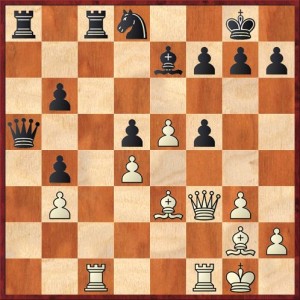
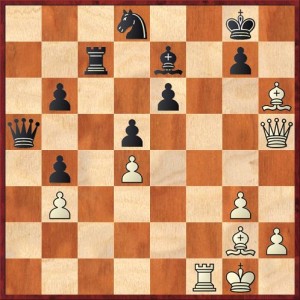
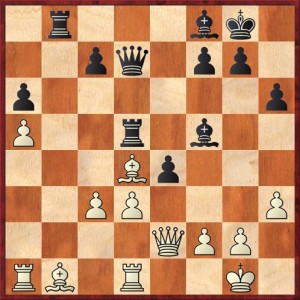
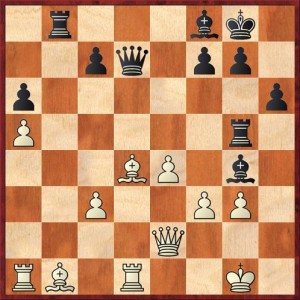
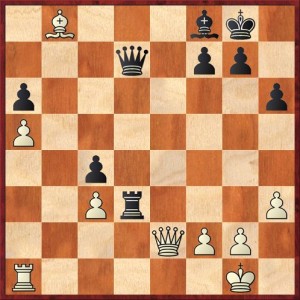



{ 9 comments… read them below or add one }
Having faced a similar choice in some recent blitz games, I think there’s another explanation: who is the stronger player?
I’m no GM, but against weaker opposition, it makes sense for me to choose a quiet line, trusting that my opponent will eventually make a mistake and if “nothing happens,” I will win. Against a stronger player, I should mix it up and roll the tactical dice. (So it’s not an absolute choice – it’s a choice against a particular player, in a particular tournament situation.)
By the same token, while the 16-year-old Carlsen might often have been playing up (ratings-wise), now he is always playing down, so he maximizes his expectation by reducing risk.
Carlsen was asked whether he considered 25. … Bxh3! in the press conference. He said no and shook his head as if that was a bizarre suggestion.
I think it’s just not the same thing comparing against superGM games. Anything works really. But its nice to examine these beautiful lines that were not played.
Yeah, the reaction of Carlsen and Svidler to the suggestion of 25…Bxh3 during the press conference was funny. Carlsen said he didn’t even consider it, as he saw a clear path to a big safe advantage. Svidler seemed annoyed that it was even brought up; his reaction was something like “I already got myself into a losing position without looking at this stuff; who cares about all these computer lines?” Neither of them seemed to think it was particularly relevant and didn’t even have any sort of “wait, how does that work, what did I miss?” reaction.
The Kramnik-Aronian press conference was also pretty funny. Kramnik was clearly very frustrated by the result. He kept on listing variations that would have won for him, except that Black had some “miracle” move to save himself. He literally used the word miracle over 20 times. Aronian even started tweaking him about it.
You seem to think that Kramnik was black against Ivanchuk. But he wasn’t, he played the white pieces. It was actually Kramnik who sac’ed the exchange to create weaknesses in black’s position and saying that Ivanchuk “allowed” the repetition means misunderstanding the nature of this struggle. Which of course is easy to do, if you put to much weight on computer evaluations.
Oops! My mistake. This is what I get for just writing about what I saw on the TV screen without actually going over the moves. I can’t believe I mixed up who was playing which side!
Another thought regarding the strategic vs tactical-solution question:
It seems to me that to cross 2800 a strong 2700 player basically has to learn one thing: To stop losing.
In other words, minimizing the risk. Topalov played some genuinely risky stuff in some tournaments (especially Linares in 2010, I think) but when he was in top form he played like Kasparov, a style that doesn’t involve much risk at all, because their attacking positions were usually a result of superior opening preparation.
Genuine risk-takers like Morozevich, Sutovsky or Shirov just don’t rise as high anymore, as it was still possible in the days of Tal.
Unless Aronian and Carlsen played against the Wicked Witch, their opposition cannot have “literally melted away.” If they’ve melted away, it’s in the figurative sense.
Enjoyed the post.
Thank you, cliche police! I actually read an article recently about this common misusage of the word “literally,” but did I learn my lesson? Noooo…
{ 2 trackbacks }